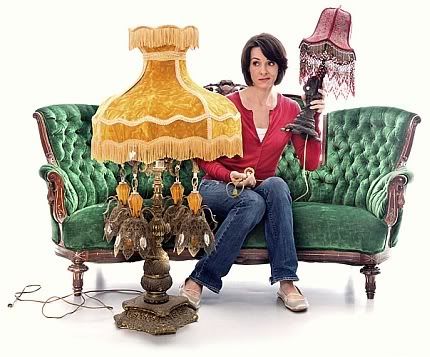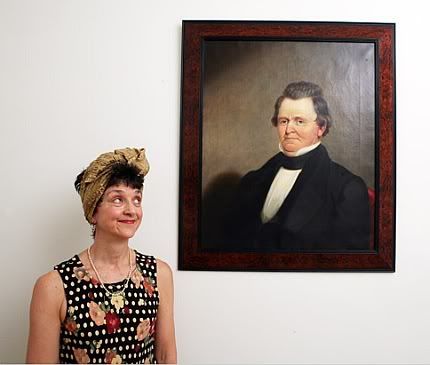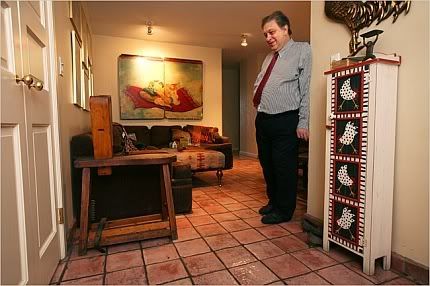La tiranía de las "herencias".
Home & Garden | |||||
| The Tyranny of the Heirloom By JOYCE WADLER Published: June 26, 2008 | |||||
 Photo Illustration by John Kuczala for The New York Times | |||||
| MELODIE BRYANT, a New York City composer, never wanted the portrait of her Uncle Ivins. There were many things she did want, when her mother moved from an elegant 2,500-square-foot apartment in Los Angeles to a far smaller place in Manhattan, but plenty of others that she didn't, though she ended up with them anyway: the mirrored Victorian vanity with tiny drawers that replaced a sturdy bureau with room for her socks, underwear and sweaters; the little armchair, mild as a timid 19th-century housemaid in a faded dress, that had survived the San Francisco earthquake but was too small to serve as a comfortable reading chair. Once that was in her Chelsea apartment, "there was no room for a reading chair," says Ms. Bryant, who is 59 and looks like the can-do, bandana-wearing women in World War II posters. "It's like a Chinese puzzle in my house you have to think three steps ahead." Then there was Uncle Ivins (who was actually a great-great-great-uncle, Ms. Bryant says). "This guy has all the family traits," Ms. Bryant says. "He's got the big honker, he's got the baby-fine hair. Nobody else wanted Ivins. I didn't want him either. But I could not let him go to some estate sale. I took him home and I was very, very careful when I placed him in the truck. I didn't want to pull some passive-aggressive move." Nonetheless, an accident occurred; the arm of a rocker ripped through the canvas. "It cost me $3,000," Ms. Bryant says. Why so much money on something she hated? "He's a relative," Ms. Bryant says. "He's family." Here is the problem with family furnishings: they are never simply stuff. As hard as it may be to dispose of a piece of furniture you bought with the fellow who turned out to be your ex-husband, it is far more difficult to get rid of a piece bequeathed to you by a member of a previous generation, which carries with it not only your memories, but his or hers as well. Even today, when so many people favor simple, modern décor, turning your back on a grandmother's tea set or ornate settee can feel like betrayal. Admit to your family you're thinking of getting rid of such a piece and you're likely to kick off a family opera, with crescendoing wails of "How could you?" Quite likely, you'll be torturing yourself with the same question. Ambivalence and guilt, it seems, are central elements of furniture inheritance, the anchoring pieces around which everything is organized, like the sofa in a living room. Barry Lubetkin, a psychologist and the director of the Institute for Behavior Therapy in Manhattan, has observed this in a number of patients living with inherited furniture they hate. It's an unhealthy setup, in which people become "slaves to inanimate objects," he says. "Once you're defining it as something you can't get rid of, you're not in control of your life or your home." There are many reasons it happens, he adds, including simple nostalgia. But it is also often connected to a primal anxiety: the fear of disappointing one's parents. Sell the Armoire, Break Mom's Heart Bonnie Barrett Stretch, 67, a contributing editor to ARTnews magazine who lives in Brooklyn, felt burdened by pieces of her dead mother's high-quality furniture. "I felt responsible for them my mother had taken such good care of them, so naturally I had to, or I wouldn't be a good daughter," she says. "I guess my relationship with the furniture was something like my relationship with her; I was never sure that I was good enough." Not that holding on to inherited things against your better judgment is always about guilt. For many people, holding on to the furnishings they grew up with creates a soothing sense of continuum a connection that can become even more powerful after a death. Sometimes an inheritor will go so far as to recreate an original tableau from childhood. Courtney Monroe, 42, a homemaker in Clayton, Del., has a massive mahogany sideboard in her dining room. On top of it are a silver tea set and silver candlesticks, set up in exactly the same way they were when they belonged to her grandmother and later her father, now both dead. "I don't even like the tea set," Mrs. Monroe says, "but it goes with the sideboard, because that's where it was when I grew up." | |||||
 Chester Higgins Jr./The New York Times Melodie Bryant, a New York composer, with her Great-Great-Great-Uncle Ivins. | |||||
John Simmons, a New York writer who is 59, refuses to part with a bedraggled travel bar that once belonged to his father, a charming Chicago businessman whom Mr. Simmons describes as "a 5 o'clock cocktail man." After Mr. Simmons's mother died, when he was in college, he and his father often went on long road trips together. His father died when Mr. Simmons was 32. "The outside of the case has a cheap leatherette covering and inside the vinyl has ripened to faded lemon yellow," Mr. Simmons wrote in a note. "The strap and lock have fallen off. My wife once offered to buy me one just like it, but what good would that do? How could that replace my father at 5 p.m., checking into some Best Western and sending me off for ice, now that the day was done and he was ready to get smashed before dinner?" The breakup of a childhood home, and the loss of security it represented, can be wrenching even for someone well into adulthood. When Susan Braudy's mother moved from her Philadelphia apartment to an assisted living home 14 years ago, Ms. Braudy, another New York City writer, and her partner, Joe Weintraub, rented a truck and rushed down. They brought back a large breakfront, paintings and drawings, a cocktail napkin signed by Frank Sinatra, Oriental rugs. Ms. Braudy was able to be coolly practical about some things. The breakfront, which was too large for her apartment, was given to a friend with a country house; the rugs, after inciting poor bathroom habits in her dogs, were given away to Housing Works. But when Ms. Braudy saw them in the organization's front window, she had an emotional meltdown. "It's terrible to see the stuff you grew up with as a child in a store window," she says. "I think I had a vision of what it would be when I died and the stuff would go to Housing Works." But dealing with the art was more complicated. Her favorite piece, a portrait, hangs in her bedroom; the rest, which she does not care for, are hidden behind a bureau. Ask Ms. Braudy, now 66, why she cannot give them away, and you will not get a short answer. They were her father's, she'll say. He worked for the Philadelphia Housing Authority, and one day he heard that a fellow employee named Dox Thrash, who was working as a house painter, had once been a Works Progress Administration artist. Her father befriended Mr. Thrash and arranged exhibitions of his work, and Mr. Thrash gave her father artworks. One of these, she discovered, had drawing on both sides of the paper the artist had been that poor. Ms. Braudy's father supported and encouraged artists; he had wanted to be a writer himself, she says, maybe that's why she became one. No Sofas Need ApplySometimes one simply cannot afford to be sentimental. Jill Krasny, a 26-year-old editorial assistant at Reader's Digest, left a Houston suburb for Westchester County a year ago, and is now ready to make her move to Manhattan. But when she came north, her parents, who are amicably divorced, paid the cost of shipping some of their old furniture, not all of which she is crazy about. In particular, she hates the couch. "It's a hot red, it screams the '80s," she says. And it is preventing her from finding a place to live. "If you move into a city, the first thing they ask you is if you have furniture," Ms. Krasny says, referring to potential roommates. "They don't care if you're dating someone, they don't care if you're a crackhead." Isn't having furniture a plus in a share? "Not having furniture is a plus in Manhattan." Can't she just tell her parents that? She has tried, Ms. Krasny says, but they brush it off. Meanwhile, she's getting more stressed. "I need to put it in storage or send it back," she says. "I'm afraid to say the word 'sell,' " she adds, though the act has crossed her mind. "People get really sentimental over objects." Lois Braverman, who is the president and chief executive of the Ackerman Institute for the Family in New York, a treatment center as well as one of the country's oldest training organizations for family therapists, once counseled a couple whose marriage was in crisis over inherited furniture. The husband had always preferred a sparse décor. The wife was "an accumulator." This had always been a source of conflict, but when the wife's mother died, there were serious problems. "She took everything, the dishes, the furniture, the pictures," Ms. Braverman says. "The living room had an extra sofa, an extra chair. Her husband felt he was going to explode." "I really worked to help her understand how differently they saw the world," she continues. "It was kinesthetic discomfort when he walked in the room and all the stuff was there, it really increased his blood pressure. She saw this as a legacy for her grandchildren and children." Are they still together? "Absolutely. And even though he was the more frugal, and storage meant spending money, they put the furniture into storage. It could be in storage for the rest of their married life." For her part, Ms. Braverman, 57, says she taught herself to resist the tyranny of inherited stuff. | |||||
 Chester Higgins Jr./The New York Times Jill Krasny, an editorial assistant whose furniture makes her an undesirable roommate. | |||||
| "I used to go home and visit my mother and she would say 'Are you sure you don't want the Limoges china?' " she says. "I would occasionally take things to please her, but eventually I got strong enough to say, Mom, it doesn't make sense for me to take them because I'm just storing them in the attic. I love you, I know you picked these things out in a loving way, but my taste is different. Why don't we think of someone in the family who would love to have these?" My Shrink Made Me Sell It There is no shortage out there of experts intent on helping us get past our inheritance hang-ups. For legatees whose legators are still living, Jane Hammerslough, the author of "Dematerializing: Taming the Power of Possessions" (Da Capo Press, 2001), feels it's important to remember that family members who are forcefully urging their possessions on their relatives don't want those items in their homes either. "Everybody thinks everything they own is so valuable, then you find out things are really a dime a dozen," she says. "EBay is kind of the great resource for those tortured by possessions, because you can see what this fabulous and rare thing is worth in a completely objective way, and separate it from, Oh, my God, I am selling my father." For those who are unable to risk family wrath by refusing or selling a piece, there is always a furniture facelift although this itself can be risky. Interior designers offer a range of tricks. Often these seem to involve high-gloss paint. James Magni, of Los Angeles, had a client who returned from a visit to her hometown in Italy with a walnut settee from her Italian Mama that just did not belong in a modern California house. "We lacquered it in a really wonderful color, sort of a mandarin orange red, and reupholstered with a horsehair fabric, like a cowhide, that made it very hip and contemporary," Mr. Magni says. Designers also seem to have no compunction about subterfuge. Joe Nye, another Los Angeles decorator, had a client whose parents gave him what Mr. Nye describes as three very ugly Erté paintings. He and the client obtained three new paintings of the same size, and when the parents arrive for one of their four visits a year, the client just does the old switcheroo. Mr. Nye admits that he is not immune from the syndrome; he, too, owns a family piece that tortures him, "this really kind of hideous Victorian settee." It belonged to his grandmother and comes from his childhood home, in Kearney, Neb. For many years it was covered with pink silk velvet fabric chosen by Mr. Nye, who is now 52, when he was 12 and redid the family living room. "It was divine," he says. So what happened? "It lost its divineness when it landed in California." Mr. Nye had a car painter spray it white and then reupholstered it in white and yellow checks, which made it look fresh for a time. When he changed his décor, he tried for chic by ebonizing it and putting taupe linen fabric on it. "It just looked like an old Victorian settee painted black with linen on it." It has now been exiled to his office. "It will never live in my house," Mr. Nye says. "But I can't get rid of it. I'd be guilt ridden, I'd have to increase my Zoloft." He has five siblings; why not give it to one of them? Mr. Nye, a glib talker, now stumbles. "I could, um, I just feel emotionally, um, it's taken me years of therapy to get over my relationship with my mother, it was something my mother just adored, so by giving it away, I would be breaching that healed relationship." Dr. Lubetkin, of the Institute for Behavior Therapy, once treated a woman who longed to get rid of an ugly bureau in her bedroom that had once belonged to her mother. He advised his patient to hire a mover to shift the bureau closer to the front door. He also led her through imagery exercises. "It's called systemic desensitization: slowly, while in a state of relaxation, have the person imagine the fearful situation occurring, having the movers come," Dr. Lubetkin says. "I also gave her an audio tape." What sort of things did he say on it? | |||||
 Chester Higgins Jr./The New York Times Barry Lubetkin, a New York psychologist, who is conflicted about his late father's cobbler's bench. | |||||
| " 'It's moving day, the bell rings, there are feelings of discomfort, but you know you can cope, you know you can get through this, this is a statement of independence from your parents.' Then in the next scene, the movers are in the apartment putting those big straps on the piece. 'You begin to feel a little emotionality, there are a couple of tears, but you relax knowing you are doing the right thing. You are going to have a fabulously decorated bedroom in just a short while.' " He May Be Overcompensating Dr. Lubetkin, who is 64 and married to an interior decorator, is meanwhile shackled to his own family piece. It's a cobbler's bench left to him by his father. Unable to find any other place for it, he keeps it in the kitchen of their large apartment on the Upper East Side. Sometimes he puts magazines on it. "It doesn't go with anything in the apartment," he says. "It makes no sense whatsoever and yet I've kept it because it's both interesting and he loved it. I'm not crazy about it, my wife's not crazy about it, but it's one of the last vestiges of things he's left." He sounds conflicted. "If someone were to come in and offer me some money I'd sell it in a New York minute." In other words, the doctor would like to get rid of it, but he doesn't want to have to take the responsibility. "Yes, clearly, there is some ambivalence." Melodie Bryant, who keeps her less-than-handsome Uncle Ivins on the wall opposite her bed, has dispatched any lingering ambivalence, reconciling herself to the inconveniences the family pieces have caused her. Sitting on an old red settee in her sofa-less living room, she needs only the piece itself to explain why. This settee, she says, belonged to a well-to-do great-great-aunt named Nelly, who lived with her husband and 4-year-old daughter in Philadelphia in the early 1900s. The child died of typhoid. After her death, the couple closed the house and never returned. It remained closed for 35 years. How could Ms. Bryant ever get rid of the red settee? Get rid of the family furniture and you're sure to lose the stories, she says; you'll lose your history. | |||||
 Stephanie Diani for The New York Times Joe Nye, a Los Angeles designer with the family settee that he has re-covered twice. | |||||
| |||||
| Open article at NYT Web Site. | |||||
